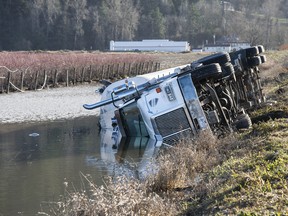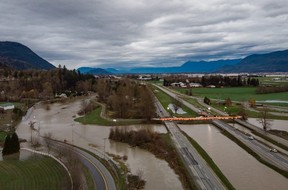Solutions could include upgrading levees and raising their height, but also moving or removing them and buying houses to restore floodplains.

.
First Nations and local governments at a forum Thursday expressed support for five principles to underpin a regional flood protection strategy for the lower Fraser River that would require billions of dollars in spending.
Announcement 2
.
The principles include understanding and reducing risk in a changing climate, promoting reconciliation with First Nations, a thriving salmon population and including everyone as part of the solution, organizers said in a post-forum briefing.
Also on the list was the goal of having sustainable and resilient economic communities planning ahead for at least 100 years.
Participants also expressed support for the regional approach, organizers said.
“The conversation will inform us about the next step of what we will be proposing to local government and Coast Salish communities on the mainland and also (high levels of) government,” said Tyrone McNeil, chair of the First Nations Emergency Planning Secretariat. and president of the Nation Stó:lo, co-host of the forum.
Announcement 3
.
“The fundamental pieces that we are looking for are to convince people about the importance of a regional plan. No local government, no First Nation can do it on their own,” McNeil said.
Solutions could include upgrading levees and raising their height, but also moving or removing them and buying houses to restore floodplains in British Columbia’s most populous region.
The first-of-its-kind forum was born out of frustration with the pace of efforts by the province and Ottawa, which hold the strings for the projects. Another frustration is bureaucratic obstacles that prevent collaborative planning and do not take into account broader goals, such as First Nations participation and decision-making, and the protection and enhancement of salmon.
Announcement 4
.

A next step could include expanding the collaboration, for example, to include farmers who would be affected by floodplain restoration, organizers said.
At the same time, it is recognized that there are projects that could be prioritized regionally, particularly if modified to include all five principles.
The organizers did not name any projects that could meet that criteria.
The City of Abbotsford recently approved a more than $2 billion plan to upgrade and move the levees.
“At this moment in the financing lottery we play against each other and we do not promote regional approaches. it’s competitive. We’re all fighting for small dollars,” said Jason Lum, president of the Fraser Valley Regional District and another co-host of the forum.
ad 5
.
Lum, a Chilliwack city councilman, said provincial and federal officials who spoke at the forum acknowledged there were gaps in the system that needed work.
-
“With these full rivers, we are very vulnerable to any kind of extreme weather pattern that might come up,” says the head of the BC Rivers Forecast Center. Article Author:Gordon Hoekstra Publish Date:June 09, 2022 • June 9, 2022 • 4 min read • Join the conversation
-
British Columbia Floods: How to Prepare Yourself and Your Home for Flooding
The forum was attended by some 140 people representing approximately half of the 31 First Nations that make up the Coastal Salish mainland and half of the 35 local governments along the lower Fraser.
BC Public Safety Minister Mike Farnworth and federal officials also attended.
ad 6
.
British Columbia, including the Fraser Valley, was hit last November by catastrophic flooding that forced 14,000 people to evacuate and caused billions of dollars worth of damage.
A recent Postmedia investigative series found that municipalities don’t have the billions of dollars needed to improve flood protection after the province offloaded responsibility on municipalities starting in 2003.
The BC government has promised a new flood strategy, but not until next year. As part of that strategy, a plan that would address the need for new levees is not scheduled until 2025.
Previously, both BC and Ottawa have committed billions of dollars to recover from the devastating floods and wildfires in BC last year.
ad 7
.
But most of that money is for response costs and human relief, helping people and communities restore buildings and infrastructure, and increasing government operating expenses.
It is not directed at building climate-resilient infrastructure, such as upgrading BC’s more than 1,100 kilometers of levees or building new or alternative flood protection measures.
Last year’s deadly floods destroyed homes and swept away roads and bridges, also disrupting the shipment of goods through ports and requiring gasoline rationing.
More news, less ads: Our in-depth journalism is possible thanks to the support of our subscribers. For just $3.50 a week, you can get unlimited, ad-lite access to The Vancouver Sun, The Province, National Post, and 13 other Canadian news sites. Support us by subscribing today: The Vancouver Sun | The province.



